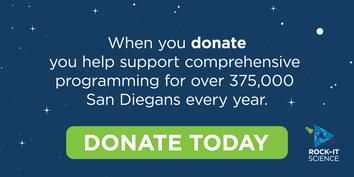Craveology Cafe and the North Star Science Store are temporarily closed for renovation.
Avery Wallace
Growing up, caring for the environment always felt natural to me. Maybe it was my love of fairies and mermaids whose cartoons always took place in pristine nature, maybe it was the fact that I was shy as a child, content making fake potions out of dirt and berries. The environment felt like an extension of my home, a place I could be at ease.
At twelve my love for the environment became a bit more academic as my fascination with nature and how the world works collided in the form of middle school science. The chemicals, the experiments, the lab safety equipment- in little Avery’s mind, it was as close to performing magic as you could get (even though titrations still make me shudder to this day- thanks AP Chemistry). However, it wasn’t until one fateful day in AP Environmental Science that I realized science was what I simply had to do in life; in fact, it was written into my genes…
That day we did an exercise on natural selection. We taped our fingers together forming a rudimentary “beak,” then competed in knock-out rounds that involved collecting as many seeds as we could from a quadrat on the floor. Our teacher then randomly assigned beneficial “mutations” before each round (i.e., different fingers being taped, different “beak” shape, or the use of opposable thumbs) to show how changes beneficial to fitness will help improve likelihood of survival. This went on until there remained one winner: me. I never received a beneficial mutation from my teacher and was still sporting the rudimentary beak we all started with, so how did I win (and no, it was not my successful history in potion making)? The answer to this question is, surprisingly, natural selection. I was born with a stunted middle finger, making it the same length as my pointer finger leaving my ring finger to be the longest. On top of that, my middle finger is missing a joint and does not bend at the proximal phalange. This allowed my rudimentary “beak” to actually be quite successful in its endeavor compared to others without this peculiarity.
I realized during that exercise that if human survival came down to collecting seeds with taped together fingers, I would absolutely thrive. This fueled my lifelong passion for discovery and showed me how science can help explain, well, everything. Superior seed skills were apparently written into my being, and in time, I discovered so was being bisexual. Weirdly, this exact seed collecting scenario has yet to present itself in real life, but until then, I’ll keep my peculiar fingers crossed and continue being the scientist- and bisexual woman- I was born to be.
Al ir creciendo, cuidar el medio ambiente siempre me pareció algo natural. Tal vez fue mi amor por las hadas y las sirenas cuyas caricaturas siempre tenían lugar en la naturaleza prístina, o tal vez fue el hecho de que era tímida cuando era niña, contenta de hacer pociones falsas con tierra y moras. El ambiente se sentía como una extensión de mi hogar, un lugar en el que podía estar a gusto.
A los doce años, mi amor por el medio ambiente se volvió un poco más académico cuando mi fascinación por la naturaleza y por cómo funciona el mundo chocaron en la materia de ciencias de la escuela secundaria. Los productos químicos, los experimentos, el equipo de seguridad del laboratorio: en la mente de la pequeña Avery, era lo más parecido a hacer magia que se podía conseguir (aunque las titulaciones todavía me hacen estremecer hasta el día de hoy—
gracias materia de Química Nivel Avanzado). Sin embargo, no fue hasta un fatídico día en Ciencias Ambientales Nivel Avanzado que me di cuenta de que la ciencia era simplemente lo que tenía que hacer en la vida; de hecho, estaba escrito en mis genes…
Ese día hicimos un ejercicio de selección natural. Nos pegamos los dedos con cinta adhesiva formando un "pico" rudimentario, luego competimos en rondas eliminatorias que involucraban recolectar tantas semillas como pudiéramos de un cuadrante en el piso. Posteriormente, nuestro maestro asignaba aleatoriamente "mutaciones" beneficiosas antes de cada ronda (es decir, diferentes dedos con cinta adhesiva, diferentes formas de "pico" o el uso de pulgares oponibles) para mostrar cómo los cambios beneficiosos para la aptitud física ayudaban a mejorar la probabilidad de supervivencia. Esto continuaba hasta que quedaba un ganador: yo. Nunca recibí una mutación beneficiosa de mi maestro y todavía tenía el pico rudimentario con el que todos comenzamos, entonces, ¿cómo gané (y no, no fue mi historial exitoso en la elaboración de pociones)? La respuesta a esta pregunta es, sorprendentemente, la selección natural. Nací con un dedo medio atrofiado, por lo que tenía la misma longitud que mi dedo índice, lo que hace a mi dedo anular más largo. Además de eso, a mi dedo medio le falta una articulación y no se dobla en la falange proximal. Esto permitió que mi "pico" rudimentario tuviera bastante éxito en sus esfuerzos en comparación con los de los otros sin esta peculiaridad.
Durante ese ejercicio me di cuenta de que, si la supervivencia humana se reducía a recolectar semillas con los dedos pegados con cinta adhesiva, yo definitivamente prosperaría. Esto alimentó mi pasión de vida por el descubrimiento y me mostró cómo la ciencia puede ayudar a explicar, bueno, todo. Aparentemente, las habilidades superiores de la semilla estaban escritas en mi ser y, con el tiempo, descubrí que también ser bisexual lo estaba. Extrañamente, este escenario exacto de recolección de semillas aún no se ha presentado en la vida real, pero hasta entonces, mantendré mis peculiares dedos cruzados y continuaré siendo la científica y la mujer bisexual que nací para ser.
